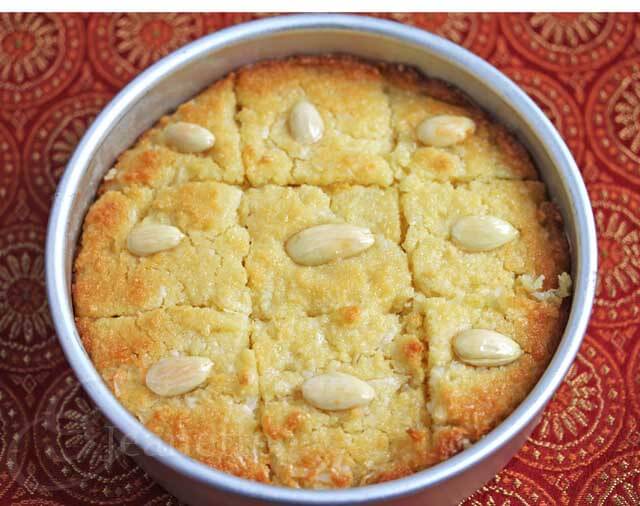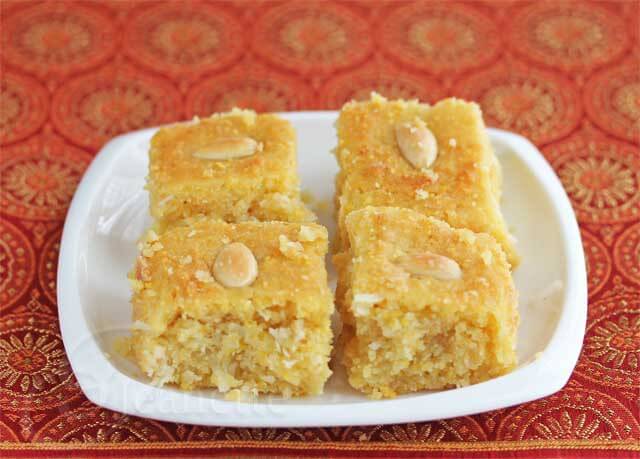 Recently, I was asked to participate in a virtual Mid-East Feast to celebrate the upcoming release of An Edible Mosaic, authored and photographed by my fellow blogging friend, Faith Gorsky. Brandy from Nutmeg Nanny is organizing this month-long event where a group of fabulous foodie bloggers has been sharing a different recipe for the past three weeks. So far, we’ve made Zucchini Fritters and Spiced Chicken Shawarma Wraps.
Recently, I was asked to participate in a virtual Mid-East Feast to celebrate the upcoming release of An Edible Mosaic, authored and photographed by my fellow blogging friend, Faith Gorsky. Brandy from Nutmeg Nanny is organizing this month-long event where a group of fabulous foodie bloggers has been sharing a different recipe for the past three weeks. So far, we’ve made Zucchini Fritters and Spiced Chicken Shawarma Wraps.
This week, we all made a Middle Eastern dessert – Semolina Cake.

I actually made my first Semolina Cake from An Edible Mosaic a few weeks ago. A good friend of mine made one for a birthday celebration last year, and I remember asking for the recipe, but alas, I never made it. Now that one of my kids is gluten-free, I can’t serve Semolina Cake to our family, so I wanted to try a version using some sort of gluten-free flour.
Since I had never made a Semolina Cake before, I decided it was best if I first made Faith’s recipe using semolina flour so I could get a sense for what the texture of the cake should be. Our local Greek market had semolina flour so it was easy enough to find. Semolina cake has a coarser texture and is denser than most cakes. Faith’s recipe calls for a sugar syrup which keeps the cake moist and goes nicely with the dryer cake.

As I pondered what flour to try substituting for semolina flour, I remembered that I had made cornbread last year using corn flour. In fact, I had read an article that corn flour was the secret to Southern cakes. It has a unique texture that is coarser than regular flour. I actually mixed some cornmeal in with the corn flour to give the cake even more texture, although I think I would make it with 100% corn flour next time. The cornmeal added a little crunch which is great in cornbread, but might be unexpected in a cake.
The first time I made this Semolina Cake, I used Faith’s sugar syrup recipe, choosing to use just half of what was called for in the recipe as our family doesn’t eat super sweet desserts. I served this to a good friend of mine when she was over for lunch one day and she loved it. So, I sent her off with the extras since I knew I was going to have to make a gluten-free version.
The second time I made this cake, in addition to substituting corn flour for semolina flour, I chose to use honey in place of sugar in the sugar syrup. I also substituted coconut oil for the butter and almond milk for dairy milk. I have to say that, while this may not be the original Semolina Cake, it was really good. I actually preferred the honey syrup to the sugar syrup. Scented with rose water, it was a fragrant way to keep the cake nice and moist.

Here are the eight other fabulous bloggers participating in the Mid-East Feast. Please pop by and see how their Semolina Cake turned out this week.
Brandy – Nutmeg Nanny
Amanda – Fake Ginger
Gina – Running to the Kitchen
Joanne – Eats Well With Others
Heather – Girlichef
Natasha – Five Star Foodie
Megan – What’s Megan Making
Rachel – Baked by Rachel
- 1 tablespoon tahini, to grease the baking pan
- 2 cups corn flour (not cornmeal)
- 2 teaspoons baking powder
- ½ cup organic sugar
- ½ cup coconut oil, room temperature
- 1½ cups almond milk
- 1 cup desiccated, unsweetened coconut
- 3 tablespoons blanched almonds
- 1 cup honey
- ½ cup water
- ½ tablespoon fresh lemon juice
- ½ tablespoon rose water (or orange blossom water)
- Put the honey, water and lemon juice in a medium, thick-bottomed saucepan, and bring to a boil over medium heat, giving the pan an occasional swirl and skimming off any foam on the surface.
- Turn heat down slightly and boil 2 minutes, swirling the pan occasionally. (The syrup will thicken more upon cooling.)
- Turn off heat and stir in the rose water (or orange blossom water); cool to room temperature.
- Preheat oven to 375°F; brush the tahini on the inside of a 10-inch round baking pan.
- Whisk together the corn flour, baking powder, and sugar in a large bowl. Stir in the coconut oil and then the milk until combined, and then fold in the coconut.
- Transfer the batter to the prepared pan and spread it out evenly; let it sit for 10 minutes.
- Score the batter into 1-inch square or diamond shapes with a sharp knife, periodically dipping the knife in hot water and drying it off before continuing to score the batter; place 1 almond in the center of each diamond.
- Bake until the sides and top are golden brown, about 30 minutes. (If the sides are brown but the top isn’t, you can broil the cake for a couple minutes to brown the top.)
- Once out of the oven, cut the cake along the lines you scored. Slowly pour the cooled syrup onto the hot cake. Let the cake sit at room temperature 2 hours to absorb the syrup before serving.
The post Gluten-Free Coconut “Semolina” Cake (Edible Mosaic) appeared first on Jeanette's Healthy Living.